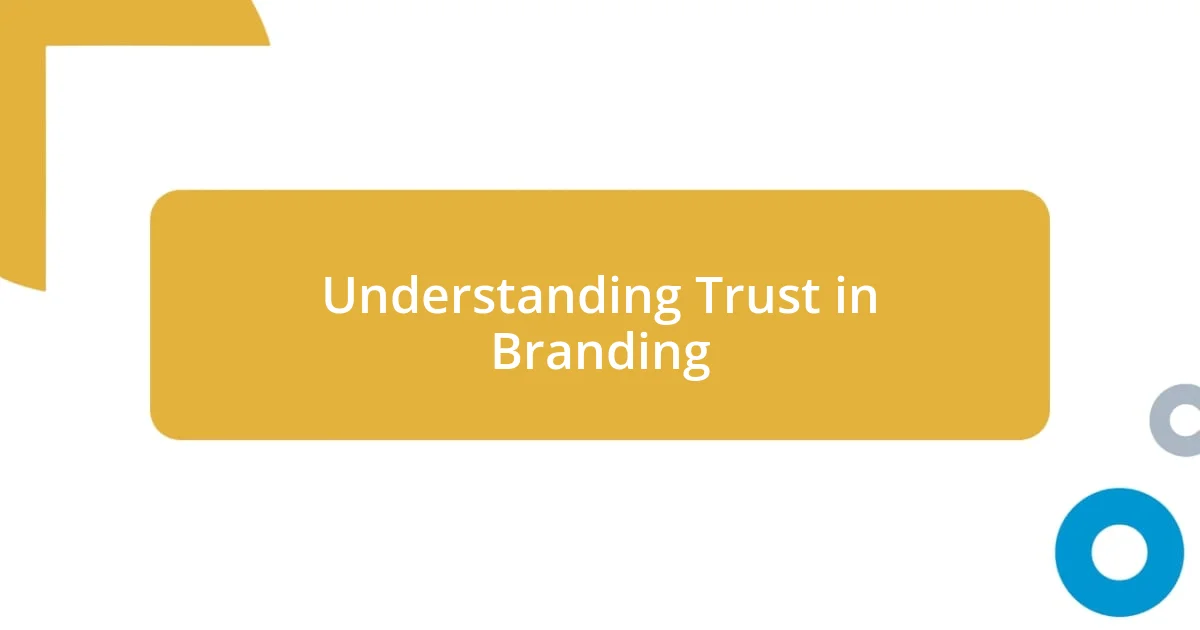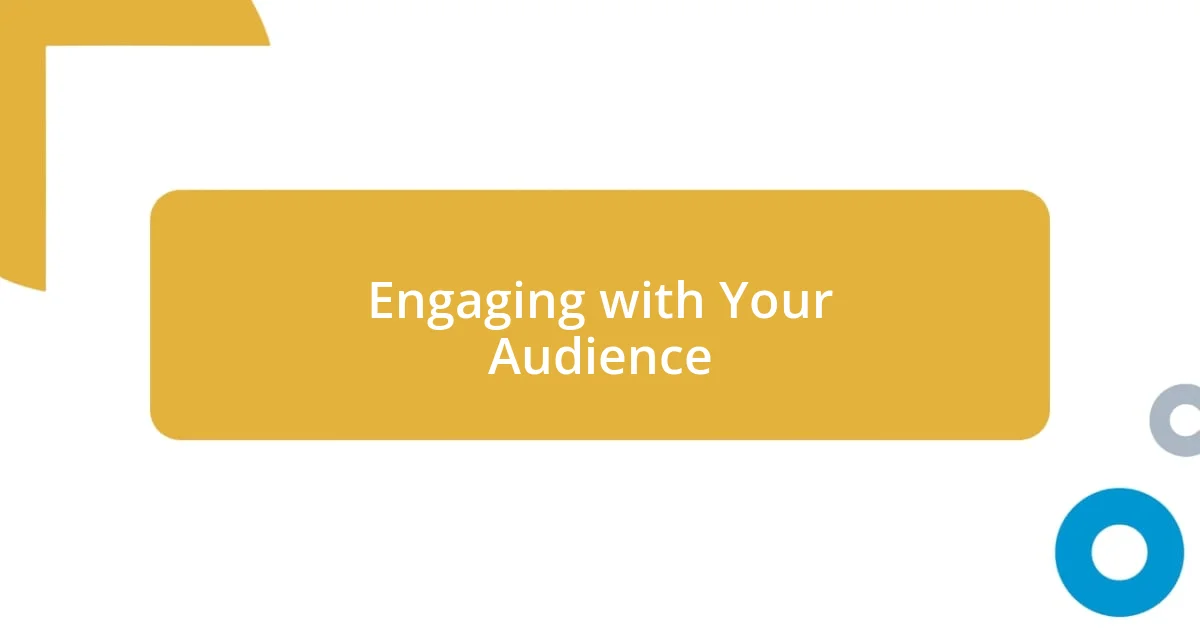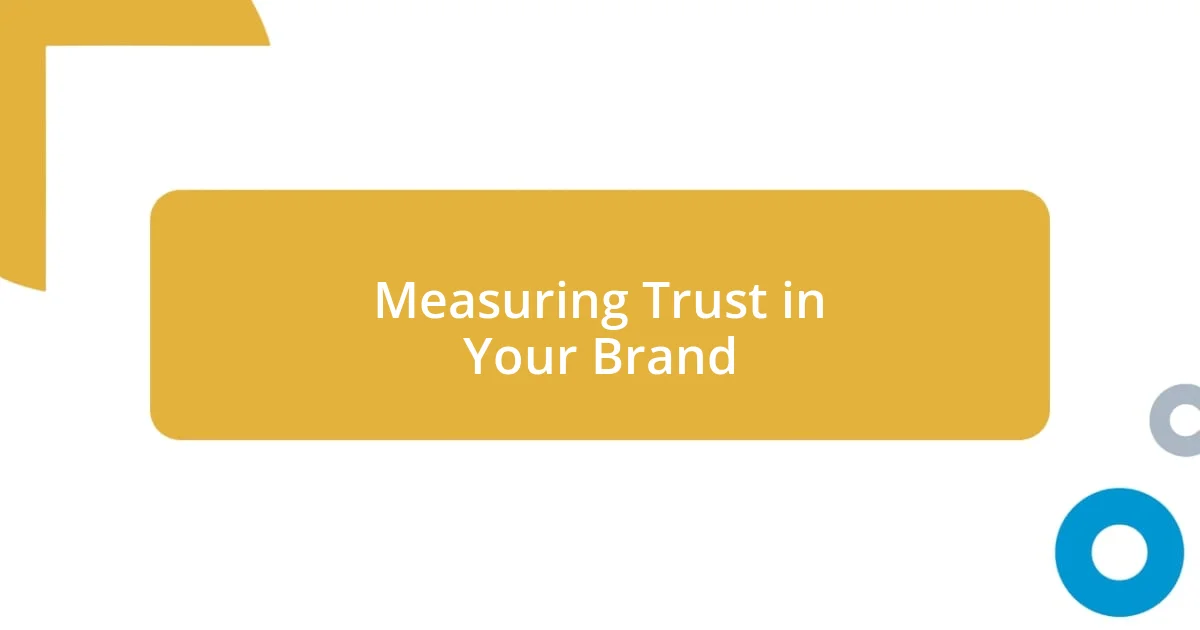Key takeaways:
- Building trust in branding requires consistency, transparency, and emotional connection with the audience through authentic storytelling.
- Engaging with customers via feedback and open dialogues fosters loyalty, making them feel invested in the brand’s journey.
- Regularly measuring trust through customer surveys and social media sentiment helps identify areas for improvement and strengthens brand relationships.

Understanding Trust in Branding
Trust in branding isn’t just a buzzword; it’s the bedrock of lasting relationships between businesses and their customers. I remember when I first launched my own brand. Gaining initial trust felt like climbing a mountain—daunting yet exhilarating. How do we build that level of confidence in a world saturated with options?
As I delved deeper into my branding strategy, I realized that consistency played a pivotal role. Each interaction, whether through social media or customer service, needed to echo our core values. I still recall an instance when a small error in an order led to a heartfelt apology and prompt resolution. The gratitude from my customer was overwhelming, and it highlighted how transparent communication can turn a potential setback into an opportunity for trust.
Furthermore, understanding the emotional connection behind branding is crucial. I often ask myself—what do I want my audience to feel? It’s about resonating with their needs and desires, creating an experience that goes beyond mere transactions. When I shared my brand’s story openly, I found that people not only engaged with my products but also with the values I represented. This connection transformed brand recognition into loyalty, ultimately reinforcing the trust I aimed to establish.

Importance of Authentic Branding
Authentic branding is essential because it cultivates a genuine connection with your audience. I learned this when I shared my entrepreneurial journey on social media. The vulnerability of showing my challenges as well as my successes made my followers feel invested in my story. They didn’t just see a brand; they saw a person, which deepened their trust.
Another aspect of authentic branding is alignment between a brand’s promise and its actual practices. There’s something incredibly powerful in staying true to your commitments. I remember when I made a public commitment to eco-friendly practices. Initially, it was a challenge to find sustainable suppliers, but sticking to my values won me loyal customers who appreciated the effort. This consistency not only built trust but also created a community around shared values.
When a brand resonates authentically, it encourages customers to share their own stories. After launching a campaign inviting customers to post about their experiences, I was amazed by the heartfelt messages I received. People shared how my brand had impacted their lives, reinforcing the emotional bond. This exchange was more than marketing; it felt like building a family.
| Authentic Branding | Transactional Branding |
|---|---|
| Builds emotional connections | Focuses on short-term sales |
| Encourages loyalty and advocacy | Results in customer churn |
| Represents genuine values | Often misrepresents brand identity |

Building Your Brand Story
Crafting a brand story is like piecing together a personal narrative. I’ve discovered that sharing the “why” behind my brand makes all the difference. For instance, when I talked about my late grandmother’s influence on my passion for artisan crafts, it sparked something in my audience. They connected emotionally, not just to my products, but to a piece of my heart. This shared journey is what keeps customers coming back—it’s about building a collective experience together.
- Define your mission: Clearly articulate what your brand stands for.
- Show vulnerability: Don’t shy away from sharing setbacks; they add depth.
- Create relatable content: Use storytelling to make your audience feel part of your journey.
- Engage with your audience: Foster conversations to personalize their experience.
- Consistency matters: Ensure that your brand’s voice aligns across all platforms to reinforce your message.
When I began emphasizing these elements in my storytelling, I noticed an uptick in engagement. Customers didn’t just see a transaction; they saw a narrative worth being part of. Each interaction turned into a chapter in a bigger story, transforming mere customers into loyal advocates. It’s these moments—where my audience feels inspired to join in—that truly build trust through branding.

Creating a Consistent Brand Experience
Creating a consistent brand experience can feel daunting at times, but I’ve found that it’s all about making small, deliberate choices. I remember when I revamped my social media presence to mirror the ethos of my brand—soft colors, consistent messaging, and a unified tone. Each post felt like a piece of a larger puzzle. Unexpectedly, I noticed a marked increase in follower engagement. People began to recognize my brand not just visually, but emotionally too—every interaction became part of their own experience with my story.
I once faced a situation where a promotional campaign went wildly off-brand due to a miscommunication. This misalignment confused my audience and eroded some of the trust I had built. After realizing the impact of that inconsistency, I committed to regular team meetings and clearer guidelines for our branding efforts. Ensuring everyone was on the same page made a significant difference, allowing us to create a seamless interaction across platforms, which my audience started to appreciate. Have you ever felt a brand was untrustworthy simply because of mixed messages?
Being transparent is crucial too. When I decided to share the behind-the-scenes of product development, it added a layer of authenticity. I often post videos of our team working on new designs, and the response has been incredible. My audience feels involved in the process, which fosters a sense of loyalty and community. After all, branding isn’t just about identity; it’s about creating a journey together, consistently engaging and bringing that experience to life for every customer.

Engaging with Your Audience
Engaging with your audience goes far beyond simply talking at them; it’s about creating a dialogue that resonates. I vividly recall a time when I hosted a live Q&A session on social media. The questions poured in, and I felt a genuine connection with those on the other side of the screen. Answering their queries in real-time transformed a one-way communication into a meaningful exchange, making my audience feel valued and heard. Isn’t that what true engagement is all about?
I’ve also learned the power of feedback. One day, after sharing a new product concept, I invited my audience to weigh in. The response was overwhelming; people shared their preferences and offered constructive insights, which not only guided my decision-making but also deepened their investment in the brand. It became clear that involving my audience in the creative process fostered a sense of ownership—when they felt their voices mattered, they formed a personal connection to the brand. Does it not make you think how often brands overlook this simple yet effective strategy?
Personal storytelling plays a crucial role, too. I remember sharing a behind-the-scenes moment where I struggled to find the right materials for an upcoming launch. Instead of hiding the challenge, I posted about it, showing my audience the real-life hurdles that come with running a brand. The messages of encouragement I received were heartwarming, and many said they appreciated me showing that vulnerability. It was rather eye-opening—it confirmed that authenticity breeds trust and strengthens relationships. Wouldn’t we all prefer to engage with brands that feel human, with relatable experiences?

Measuring Trust in Your Brand
Trust is a crucial component of any brand, and measuring it can be quite enlightening. I remember after implementing a new customer service initiative, I decided to survey my clients about their experiences. The results were not just numbers; they revealed heartfelt sentiments about reliability and support. This feedback helped me gauge where we stood and highlighted areas needing improvement—do you track how your audience feels about your brand’s trustworthiness?
I’ve also found that analyzing social media sentiment is essential. One day, I discovered a wave of positive comments following a campaign focused on community involvement. Monitoring metrics like engagement rates and sentiment analysis offered valuable insight into trust levels. These metrics serve as a real-time pulse check on how my audience perceives my brand—are you paying attention to the conversations happening around your brand?
Another method I utilize is focusing on customer retention rates. There was a point when I noticed an uptick in repeat purchases, which signaled that my efforts to build trust were paying off. When customers return, it’s often a strong indicator of their loyalty and faith in the brand. Each returning customer feels like a confirmation of my branding efforts, reinforcing that I’m on the right path. Trust isn’t just built; it’s measured in the relationships I cultivate along the way.

Adjusting Your Branding Strategy
Adjusting your branding strategy can often feel daunting, but it’s essential for maintaining trust. I recall when I realized our messaging was starting to feel outdated. After brainstorming with my team, we revamped our visuals and tone to better reflect current trends. It was a lightbulb moment when I saw our audience reconnecting with the refreshed brand identity. Isn’t it fascinating how a simple adjustment can reignite interest?
I’ve also had experiences where minor tweaks led to significant shifts. For instance, I once noticed our customer interactions were more casual and friendly, yet our branding still seemed formal. By shifting our language to match the warmth that our customers displayed, I found that engagement soared. Have you ever considered how aligning your brand’s voice with your audience’s could elevate your connection with them?
Additionally, I learned the importance of staying agile. During a particularly tumultuous time, our audience craved authenticity and empathy. So, I shared a candid post about how our team was navigating those challenges. It not only reassured our followers, but also solidified their trust. Looking back, it’s clear that those authentic moments of vulnerability in branding are what truly resonate. How often do you reflect on the evolving needs of your audience and adjust your strategy accordingly?














